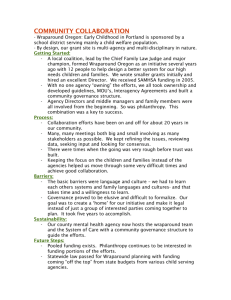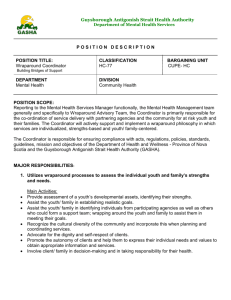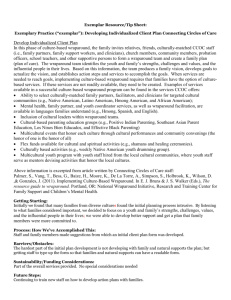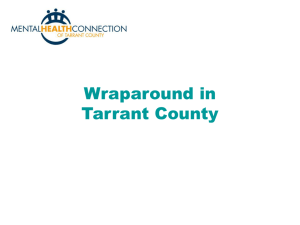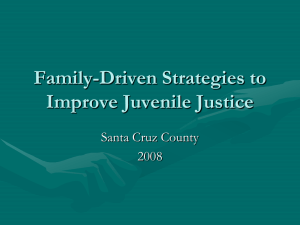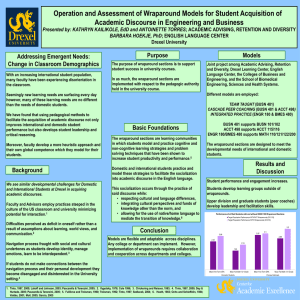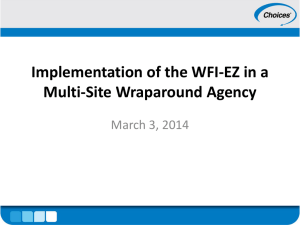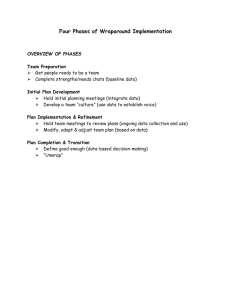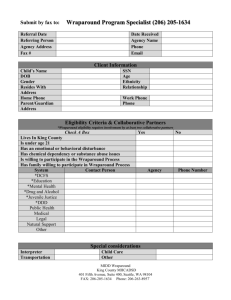NHCBH Workforce Development Network Foundational Competencies in
advertisement
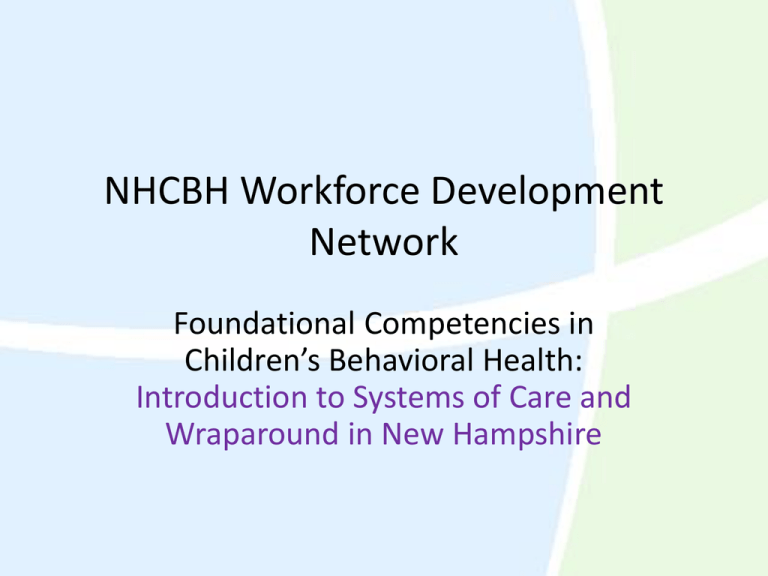
NHCBH Workforce Development Network Foundational Competencies in Children’s Behavioral Health: Introduction to Systems of Care and Wraparound in New Hampshire Foundational Competency Modules • These modules are designed to support the implementation of core competencies in Children’s Mental Health. • The competencies are formulated at foundational, intermediate and advanced levels. • The following modules provide introduction to the core competencies and are supported by the Professional Development Workgroup of the NHCBH Workforce Development Network. Mission • The mission of the NH Children’s Behavioral Health Workforce Development Network is to build a sustainable infrastructure for the professional development of the children’s behavioral health workforce based upon the core competencies and infused with the system of care core values and guiding principles. Wraparound NH: What It Is, What It Is Not: Family Teams and Systems Level Supports New Hampshire Children’s Behavioral Health Collaborative Workforce Development Network Wraparound Workgroup Spring 2015 The Context: Systems of Care “A spectrum of effective, community-based supports, that is organized into a coordinated network, builds meaningful partnerships with families and youth, and addresses their cultural and linguistic needs, in order to help them to succeed at home, in school, in the community, and throughout life” (Stroul & Friedman, 2010) System of Care Values 1. Family driven and youth guided 2. Community based 3. Culturally and linguistically competent 2010, Beth A. Stroul, M.Ed. Gary M. Blau, Ph.D. Robert M. Friedman, Ph.D. Updating the System of Care Concept and Philosophy Family and Youth Driven The strengths and needs of the child, and family determine the types of services and supports provided. Community Based The locus of services as well as system management rest within a supportive, adaptive infrastructure and relationships at the community level. Culturally and Linguistically Competent Agencies, programs, and services reflect the cultural, racial, ethnic, and linguistic differences of the populations they serve to facilitate access to and utilization of appropriate services and supports and to eliminate disparities in care. Positive Outcomes of System of Care Development and Implementation • Increased positive social, academic, and behavioral outcomes and community connectedness for children, youth, and families • Decreased out of home, school, and community placements (and duration of such) • Increased caregiver capacity, decreased caregiver strain • Programs and supports that are uniquely tailored to each child and family’s culture, strengths, and dreams (Suter & Bruns, 2009; Bruns & Suter, 2010) History • 1960s – Brownsdale programs developed needs based, individualized, unconditional services for children with emotional disturbance. • Jane Knitzer monograph Unclaimed Children • 1980s – National Institute on Mental Health provided funding for child-centered service systems (beginning of “standing wraparound teams” regionally in NH) History (cont.) • Stroul and Friedman Monograph, 1986updated 2010, “A System of Care for Children and Adolescents with Severe Emotional Disturbances” • 1990s – Federal Center for Mental Health Services supported development of Systems of Care- 2000 NH receives first System of Care grant- CARE NH.. History (cont.) • Wraparound (1980’s, 2000’s)- Child Welfare: Karl Dennis at Kaleidoscope Chicago, Vandenberg in Alaska, Wrap Milwaukee, Eber in Illinois (move toward school based Wraparound) • Similar developments in other fields: – Developmental Disabilities: “Person-Centered Planning,” “Personal Futures Planning” – Child Welfare: “Family Group Decision Making” The Wraparound Process: Evolution The National Wraparound Initiative (NWI) defines Wraparound as “an intensive holistic method of engaging with individuals with complex needs (most typically children, youth and their families) so that they can live in their homes and communities and realize their hopes and dreams.” The Wraparound NH Model Wraparound brings families together with supportive teams to plan and deliver supports and services that build on family-identified strengths and needs, to help families live together safely and productively in the community. What is Wraparound? • Wraparound is highly-structured family-driven planning process. • Wraparound is based in a clear set of values and principles. • Wraparound teams have dynamic rather than static membership. • Wraparound is a process that begins with the strengths of individual youth and families. • Wraparound is not a service or set of services. • Wraparound is highly individualized. What is Wraparound? • Wraparound is a solution-focused process that is family and youth driven. • Wraparound connects families to supports and services in their communities, and always includes a mix of public, private, and natural supports. • Wraparound includes access to family/youth peer support. • Wraparound is a process that respects families’ culture and values. • Wraparound is led by a trained facilitator. Wraparound Is Not: • • • • • • A specific set of services offered A typical team meeting Any meeting held without family or youth An immediate or quick solution A crisis intervention or response A standing interagency team NH Wraparound Framework 4 Phases of Wraparound Framework • Hello: Initial contacts of welcoming and setting the stage for “engaged enough” • Help: Agreeing on, providing and delivering a range of interventions, services & supports • Healing: Modifying initial helping activities to produce family report of healing • Hope: Future oriented activities designed to sustain family experience of hope June 14 patmiles@patmiles.com Hello Help Healing Hope Phase 1: “Hello” • Involves a sense of being welcomed which sets the stage for enduring equal partnership• Hello conveys the experience of being greeted and appreciated that families deserve to feel as they enter Wraparound. • Provides comfort while quickly gathering enough information to assemble a helping response on the foundation of the initial greeting. Activities and Tools at Hello • • • • • Listen for understanding Family Timeline- Family Culture Map Strengths Discovery and Strengths Summary Identify and prioritize needs- Needs Egg Identify any immediate safety threats and respond- Risk Assessment Matrix • Connections and Supports Map • Create the family’s vision Phase 2: “Help” • Families are usually more interested in getting help than in a completed plan. • Build a team, identify team member strengths and roles, decide what to work on, develop strategies. • A Child and Family Team is not the intervention but is the way that decisions get made about the range of interventions. Activities and Tools at Help • Blend multiple perspectives • Plan of Care • Benchmarking, evaluating, and monitoring progress • Continuous Engagement Activities • Brainstorming- at least 10 ways to meet each prioritized need • Empower to action • Establish and adjust safety plan • Review progress towards the family’s vision Phase 3: “Healing” • Healing is the restoration of the family's sense of health and wholeness, as they take charge of identifying, accessing, and utilizing the supports and services they need. Activities at Healing • • • • • • Check commitments and follow through Assess information about benchmarks Rate progress towards family’s vision Establish wellness plan Identify new strategies Review and adjust safety plan Phase 4: “Hope” • Hope begins to happen when the family’s underlying needs are being met and the family’s vision is realized. • When the right supports are in place, transition planning and commencement happen. Activities at Hope • Identify contingency plans, ways to “come back” • Create a transition portfolio • Define hopes and dreams for life “after Wrap” • Identify supports and resources beyond Wraparound Planning Process tenure • “What if” drills Weaving the Phases Together “Just as hello isn’t something that only happens at the outset of the arc of care, hope isn’t confined to the closing moments. Hello should kindle and nurture hope throughout the course of the process. Help should be delivered in the context of a powerful optimism designed to increase expectancy on the part of all team members as well as families. Healing should be recognized throughout the entire process of Wraparound as a way to acknowledge and celebrate gains and set the stage for a future of possibilities” –Pat Miles, 2014 Wraparound in Simplest Terms • Work until it works. • When barriers arise--- People haven’t failed- the plan needs to be reworked. • Strengths + Needs= Actions • Voice and choice. • If it doesn’t feel like help, it probably isn’t. • No shame, no blame FAST Forward NH Project • 4-year System of Care project funded by the federal Substance Abuse and Mental Health Services Administration (SAMHSA) • Goals: – Establish family/youth-driven wraparound in NH – Establish a funding, policy, and systems administration to support System of Care and wraparound development in NH FAST Forward NH Project Roles: Wraparound NH Coordinators in the Fast Forward Project (2012-2016): • Works with families to establish wraparound teams, hold initial meetings with families, facilitates wraparound meetings and performs care coordination, facilitates referrals to other supports and services, develop crisis plans, facilitates the development of the family’s vision and plan of care, collaborates with Family and Community Support Specialists, collects data and completes required documentation. Roles (cont.) Family and Community Support Specialists• Member of the individual and family team; supports and coaches the family in the wraparound process; assists family to identify, prioritize, and articulate their goals and needs. • Ensure that the family’s culture is respected; provide peer to peer support that will include helping the family learn how to navigate and advocate within the system; and work with the family to gain insight of the other team members perspective. • Provide families with information about and connect them with natural supports and resources. Breaking Down Silos For NH’s Top-Tiered Children in Need of Mental Health Services NH’s SOC Service Array CMHC Services The braiding of services and funding sources will result in children being served more effectively in their home communities, with enhanced services from both systems. DCYF Service FAST Forward- System of Care Service Array • • • • Enhance and expand traditional service array Develop new, non-traditional supports Natural, unpaid, community based supports All team members commit to developing natural community supports and connections NH System of Care Individuals in FAST Forward have access to a full service array • • • • • • • • • • • Assessment and diagnostic evaluation Care coordination/wrap facilitation Outpatient therapy: Office based, individual, group and family therapies Participation in wraparound meetings: Stipends for team members Medication management Psychiatric/medication consultation Mobile Crisis intervention Community Youth Mentor/behavioral aide service School based behavioral health services Substance Use intensive outpatient treatment Substance use disorder support services • • • • • • • • • • • Therapeutic Day Treatment: after school programs ISO in home supports Home Based Therapeutic Support Child Health Support/Parent Aide Crisis Stabilization: out of home Respite Services Therapeutic Foster Care: ISO foster care Residential Treatment *Family Support, Leadership and Education *Youth Peer Support, Leadership and Education Flexible Funds Care Management Entity (CME) The NH Division of Children, Youth and Families as the CME Family/Youth Level: Referrals, eligibility and payment process • Accepts referrals (Erica Ungarelli and Adele Gallant) • Screening for eligibility of family, self or school direct referrals when one has not yet been done (using NH CANS) (Erica & Adele) • Works with referent on Crisis Plan when necessary (Erica & Adele) • Medicaid payment processing (pa’s entered into MMIS): (DCYF Provider Relations) Care Management Entity (cont.) DCYF as CME System Level: • Develops provider network to provide SOC service array with Managed Care Organizations (MCOs) – utilizing current DCYF/Bureau of Behavioral Health (BBH) providers (Adele and Erica, DCYF provider Relations and BBH) • Works at developing private insurance network (DCYF Fiscal Specialists) • Develops/joins regional teams to assess capacity and barriers and community partnership –(Adele/Family Organizations) • Service utilization management, Quality improvement, Information technology-web based system. (Adele, Erica and DCYF’s data and evaluation groups) • Manages the contracts and supervises with Fast Forward Coordinators “Family to Family” Support, Education and Leadership Training • • • • SUPPORT 1:1 Time Limited Support GroupCommunity Facebook page Message Board EDUCATION • PMC Family Education Program • Webinars • Annual Conference • • • • LEADERSHIP TRAINING PMC Teacher Support Group Facilitator “Life Interrupted” -Speaker “It’s Your Move”-Advocacy F.A.S.T. Forward Expand “Family to Family” Support, Education and Leadership Training + 1:1 Support-Wraparound + PMC Family Education Program + Family Leadership Training Identify, recruit and provide on-going technical assistance to family leaders serving on a wide range of activities on the local, state and national levels. Youth Leadership and Development of Youth Peer Support Granite State Federation of Families for Children’s Mental Health Individual Level: Training and Support System Level: Training and Support Training for youth to drive Youth Move Orientation, their own planning Focus Groups Group Forums for Individual Support and Connections (YM and RENEW Facebook) Leadership Youth Voice and Perspective to Systems Change Efforts “Strategic Sharing” Conference Planning and “What Helps What Co-Hosting: Youth Track Harms”- YM National Development Social Marketing Initiative Development of 1:1 Youth Training and Recruitment Peer Support Model of Youth for Action in Systems Change Support and technical assistance to emerging youth leaders across systems Organization of Workforce Development Activities (6/2014) NHCBH Workforce Development NetworkLeadership Team Evidence-based Practice Workgroup Children's MHC Directors Workgroup YouthMOVE Peer to Peer Training Institutions of Higher Education (IHE) Workgroup Youth Mental Health First Aid Wraparound Workgroup Multi-tiered System of Support School-based Web-Based Learning Infrastructure In-service Workgroup Web-Based Content Note. SAMHSA = Substance Abuse and Mental Health Services Administration; CBHC = New Hampshire’s Children’s Behavioral Health Collaborative; DHHS = Department of Health and Human Services; DCYF=Division of Children, Youth, and Families; IOD = University of New Hampshire’s Institute on Disability; NAMI NH = New Hampshire chapter of the National Alliance for the Mentally Ill; GSFFCMH = Granite State Federation for Children’s Mental Health; AUNE = Antioch University New England. FAST Forward Youth/Family focused logic model Note. SAMHSA = Substance Abuse and Mental Health Services Administration; CBHC = New Hampshire’s Children’s Behavioral Health Collaborative; DCYF = Department of Children, Youth, and Families; NAMI NH = New Hampshire chapter of the National Alliance for the Mentally Ill; GSFFCMH = Granite State Federation for Children’s Mental Health; AUNE = Antioch University New England FAST Forward Eligibility and Referral • Eligibility: – Child or youth, ages 8 to adult transition age – Meets state eligibility criteria for Serious Emotional Disturbance (SED)- multiagencycategory – At risk for out of home placement – Enrolled in NH Medicaid program Contact: Adele Gallant, 603-271-4371 “Training on the phases should explore ways in which families experience their participation with helpers during each of the phases. Through engagement families should feel a sense of being heard and understood, through planning a sense of having caring people joining with them to make a difference in their lives, Through implementation an improved ability to cope with challenges in their lives, and through transition a sense of self-efficacy and optimism for the future.” Pat Miles Contacts For more information on Fast Forward or to refer a family: Adele Gallant, MS FAST Forward Program Manager DCYF/ Bureau of Well-Being Thayer Building 129 Pleasant Street Concord, NH 03301 P: (603) 271-4371 F: (603) 271-4677 adele.c.gallant@dhhs.state.nh.us
